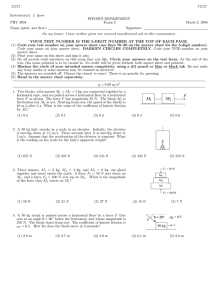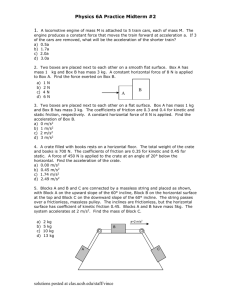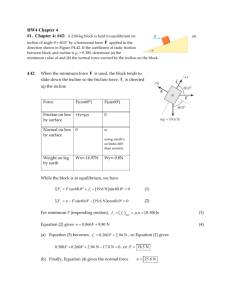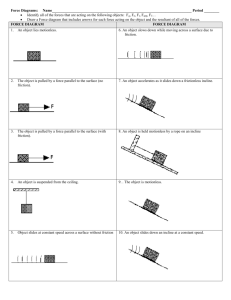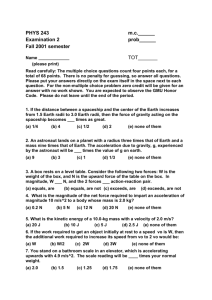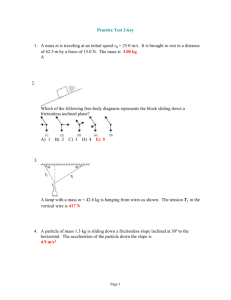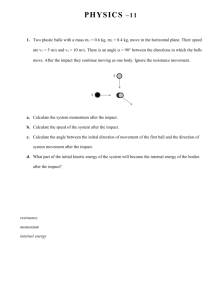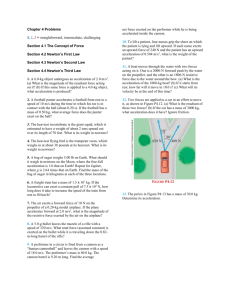Afo rce F = 10mg lifts three blocks m1 = m,
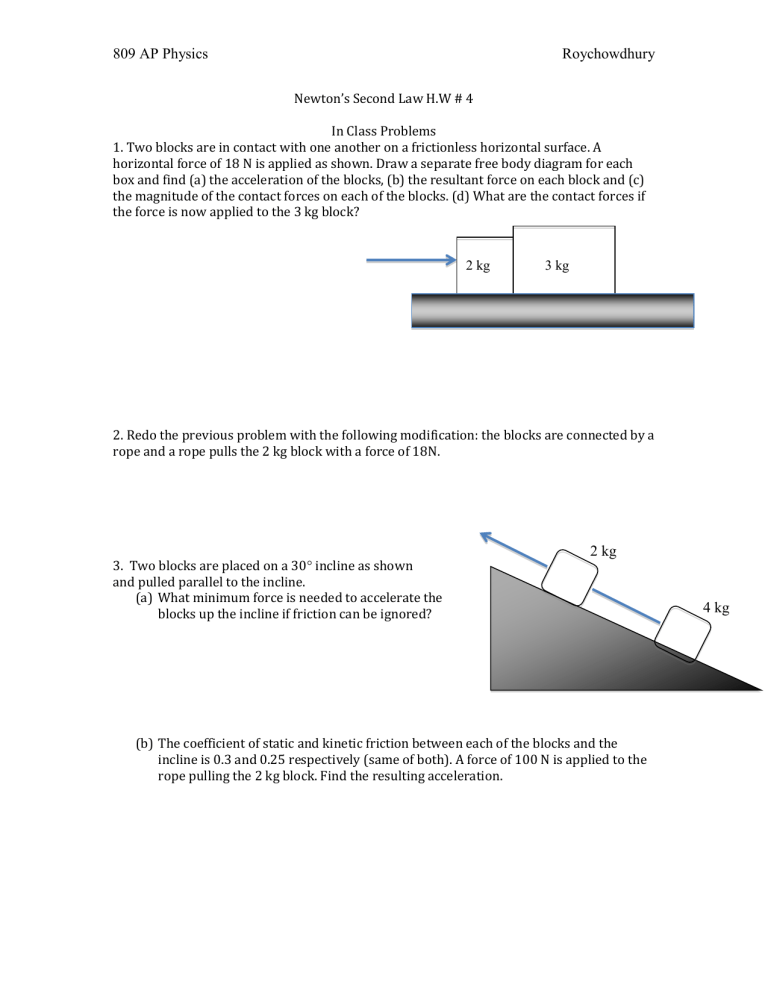
809 AP Physics Roychowdhury
Newton’s Second Law H.W # 4
In Class Problems
1. Two blocks are in contact with one another on a frictionless horizontal surface. A horizontal force of 18 N is applied as shown. Draw a separate free body diagram for each box and find (a) the acceleration of the blocks, (b) the resultant force on each block and (c) the magnitude of the contact forces on each of the blocks. (d) What are the contact forces if the force is now applied to the 3 kg block?
2 kg 3 kg
2. Redo the previous problem with the following modification: the blocks are connected by a rope and a rope pulls the 2 kg block with a force of 18N.
3. Two blocks are placed on a 30 incline as shown and pulled parallel to the incline.
(a) What minimum force is needed to accelerate the blocks up the incline if friction can be ignored?
2 kg
(b) The coefficient of static and kinetic friction between each of the blocks and the incline is 0.3 and 0.25 respectively (same of both). A force of 100 N is applied to the rope pulling the 2 kg block. Find the resulting acceleration.
4 kg
809 AP Physics Roychowdhury
Newton’s Laws H.W # 4
1. A 5.0 kg block placed on an inclined plane is acted on by a horizontal force F with magnitude
50 N. The coefficients of static and kinetic friction between block and plane are 0.35 and 0.30 respectively. (a) What is the acceleration of the block if it is already moving up the plane? (b)
With the horizontal force still acting, how far up the plane will the block go if it has an initial upward speed of 4.0 m/s? (c) What happens to the block after it reaches the highest point (Force
F is still acting)?
F
37°
2. Box B has a mass of 20kg. The coefficient of static friction between block and horizontal surface is 0.60 and the coefficient of kinetic friction is 0.40. Find the maximum mass of block A for which the system will be stationary.
45°
B
A
3. A block of 5 kg is pulled by a force 10 N making an angle 30° with the incline of angle 45°. If the coefficients of static and kinetic friction are 0.55 and 0.53, then determine the force of friction (magnitude, type and direction) between block and incline.
30°
45°
809 AP Physics Roychowdhury
5.
4. A 3 kg block is pushed along the ceiling with a constant applied force of 46 N that acts at an angle of 60 with the horizontal as in the figure. The block accelerates to the right at 6 m/s 2 .
Determine the coefficient of kinetic friction between the block and the ceiling.
A block is placed on a plane inclined at 22 to the horizontal with a frictional coefficient of
0.2. A 25 N force acting down at 15 with the plane (α = 15 ) is required to push the block up the incline with constant velocity. What is the weight of the block?
6. A 2 kg block on a horizontal surface has been given a speed of
10m/s to the right. The coefficient of kinetic friction between the block and the surface is
0.2. A time varying force given by F(t) = (14 – 4 t) also acts on the block (the function takes care of the direction i.e direction is to the right when the force is positive and to the left when the force is negative).
(a) Find v(t) for the block.
(b) When is the speed maximum? What is the maximum speed?
(c) When is the speed zero?
7. A force F = 10mg lifts three blocks m
1
= m, m
2
= 2m, m
3
= 3m, connected by inextensible strings, which can be considered massless. Find the acceleration a, tensions T
1
and T
2
.
809 AP Physics Roychowdhury
8. Consider a force F = 50 N, pulling 3 blocks of identical masses, where each mass is m = 1 kg, along a smooth horizontal surface. The acceleration of the blocks is a. Find the acceleration a, tensions T
1
and T
2
.
9. The surface of the inclined plane is frictionless.
M
1
= 2 kg, M
2 in the string?
= 3 kg. If the acceleration is 1.3 m/s 2 up the incline, what is F and the tension
10. The surface on which the blocks rest is frictionless. M
1
= 2 kg, M
2
= 3 kg. What is the force F if the resulting acceleration of the blocks is 2 m/s 2 . Also find the normal forces exerted on the blocks by the surface as well as the tension in the connecting cord. and a.
M
1
M
2
30
11. There is no friction between the blocks and the surface below. If M = 1 kg and the magnitude of the tension of the connecting string on the smaller block is 3 N, determine F
F
809 AP Physics Roychowdhury
